Labour Flexibility & Recession 2008: An Evaluative Report - EID
VerifiedAdded on 2023/06/03
|17
|3831
|230
Report
AI Summary
This report critically evaluates a journal article on labour flexibility and employment practices during the 2008 recession, focusing on an automotive case study. It summarizes the core findings of the article, assesses its strengths and weaknesses regarding methodology, argument structure, and literature review, and discusses the relevance of the findings beyond the UK. The report also examines the impact of the recession on the automotive industry, highlighting the use of functional, numerical, and working time flexibility to manage workforce demands. Ultimately, the report draws conclusions about the article's value and provides recommendations for future research and professional practice in labour flexibility, emphasizing the importance of adapting to fluctuating market conditions while protecting core staff.
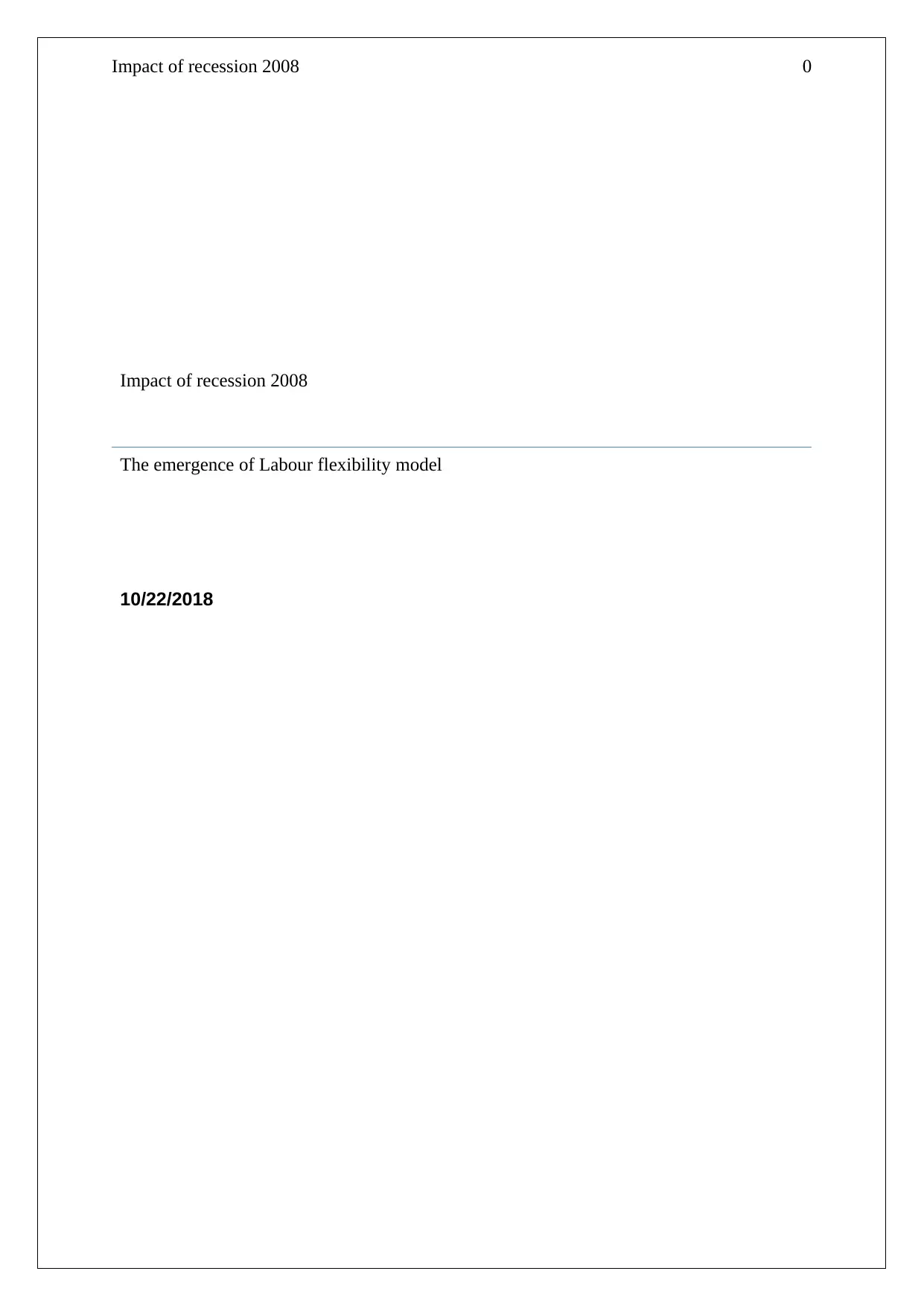
Impact of recession 2008 0
Impact of recession 2008
The emergence of Labour flexibility model
10/22/2018
Impact of recession 2008
The emergence of Labour flexibility model
10/22/2018
Paraphrase This Document
Need a fresh take? Get an instant paraphrase of this document with our AI Paraphraser
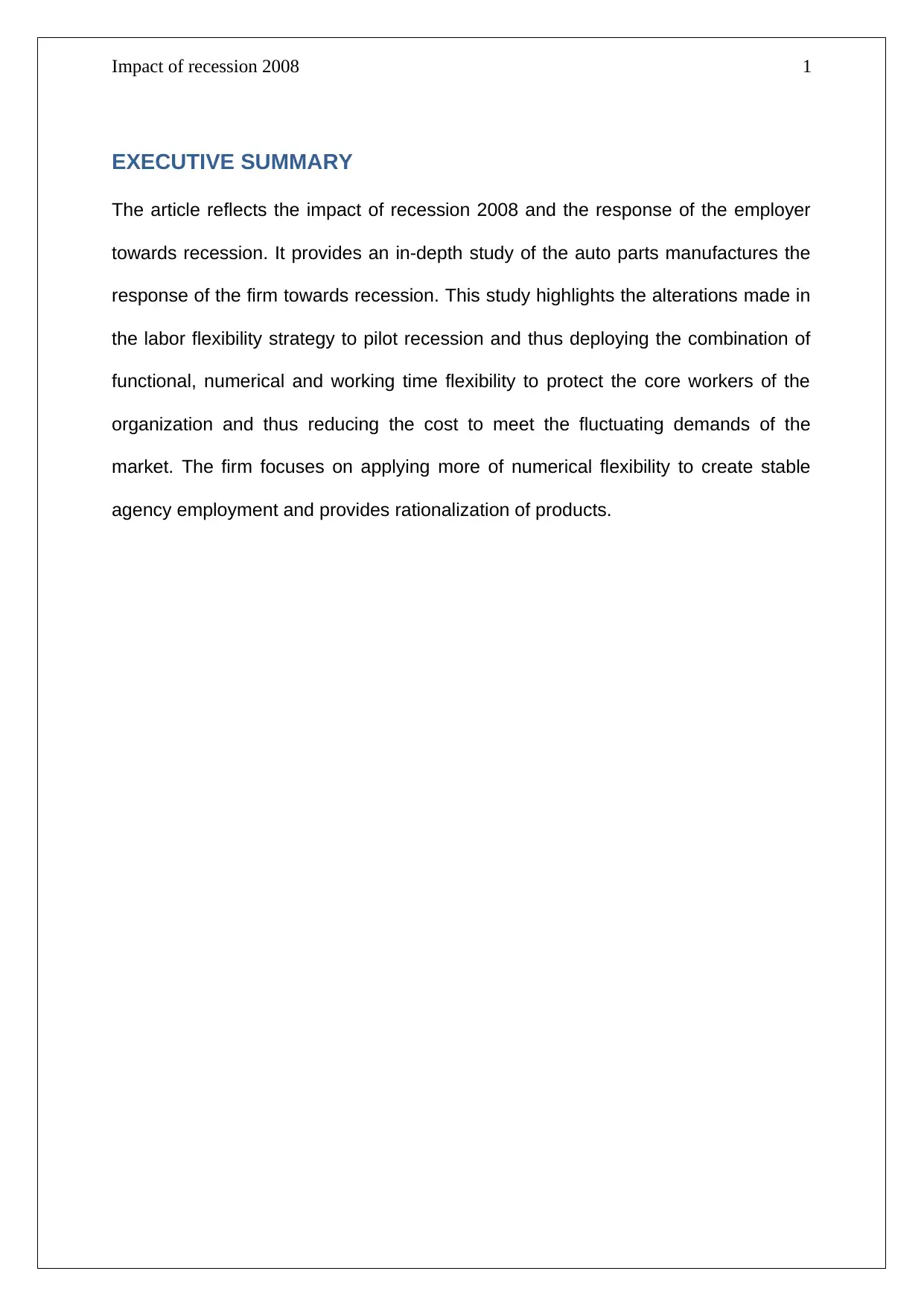
Impact of recession 2008 1
EXECUTIVE SUMMARY
The article reflects the impact of recession 2008 and the response of the employer
towards recession. It provides an in-depth study of the auto parts manufactures the
response of the firm towards recession. This study highlights the alterations made in
the labor flexibility strategy to pilot recession and thus deploying the combination of
functional, numerical and working time flexibility to protect the core workers of the
organization and thus reducing the cost to meet the fluctuating demands of the
market. The firm focuses on applying more of numerical flexibility to create stable
agency employment and provides rationalization of products.
EXECUTIVE SUMMARY
The article reflects the impact of recession 2008 and the response of the employer
towards recession. It provides an in-depth study of the auto parts manufactures the
response of the firm towards recession. This study highlights the alterations made in
the labor flexibility strategy to pilot recession and thus deploying the combination of
functional, numerical and working time flexibility to protect the core workers of the
organization and thus reducing the cost to meet the fluctuating demands of the
market. The firm focuses on applying more of numerical flexibility to create stable
agency employment and provides rationalization of products.
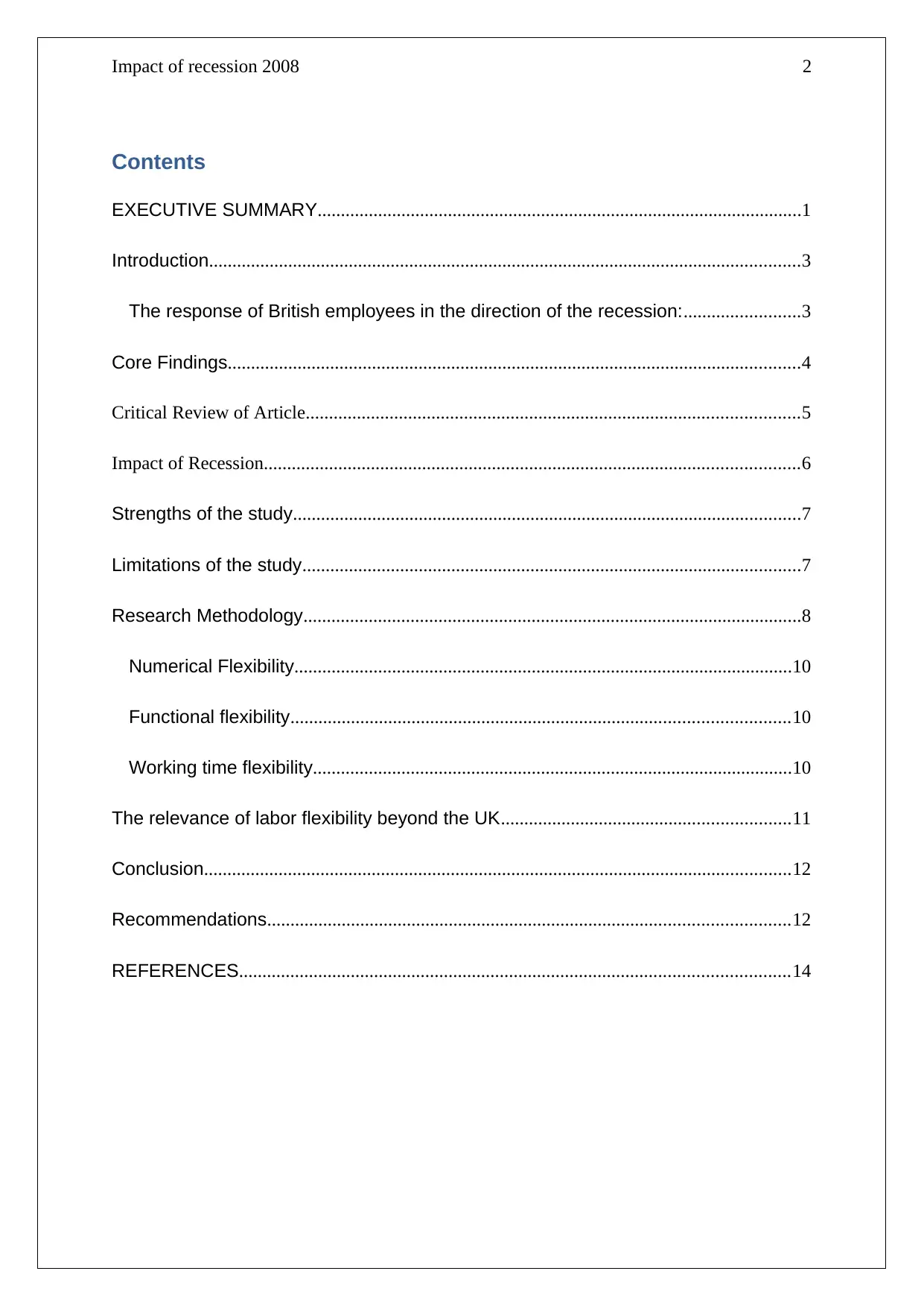
Impact of recession 2008 2
Contents
EXECUTIVE SUMMARY........................................................................................................1
Introduction...............................................................................................................................3
The response of British employees in the direction of the recession:.........................3
Core Findings...........................................................................................................................4
Critical Review of Article..........................................................................................................5
Impact of Recession...................................................................................................................6
Strengths of the study.............................................................................................................7
Limitations of the study...........................................................................................................7
Research Methodology...........................................................................................................8
Numerical Flexibility...........................................................................................................10
Functional flexibility...........................................................................................................10
Working time flexibility.......................................................................................................10
The relevance of labor flexibility beyond the UK..............................................................11
Conclusion..............................................................................................................................12
Recommendations................................................................................................................12
REFERENCES......................................................................................................................14
Contents
EXECUTIVE SUMMARY........................................................................................................1
Introduction...............................................................................................................................3
The response of British employees in the direction of the recession:.........................3
Core Findings...........................................................................................................................4
Critical Review of Article..........................................................................................................5
Impact of Recession...................................................................................................................6
Strengths of the study.............................................................................................................7
Limitations of the study...........................................................................................................7
Research Methodology...........................................................................................................8
Numerical Flexibility...........................................................................................................10
Functional flexibility...........................................................................................................10
Working time flexibility.......................................................................................................10
The relevance of labor flexibility beyond the UK..............................................................11
Conclusion..............................................................................................................................12
Recommendations................................................................................................................12
REFERENCES......................................................................................................................14
⊘ This is a preview!⊘
Do you want full access?
Subscribe today to unlock all pages.

Trusted by 1+ million students worldwide
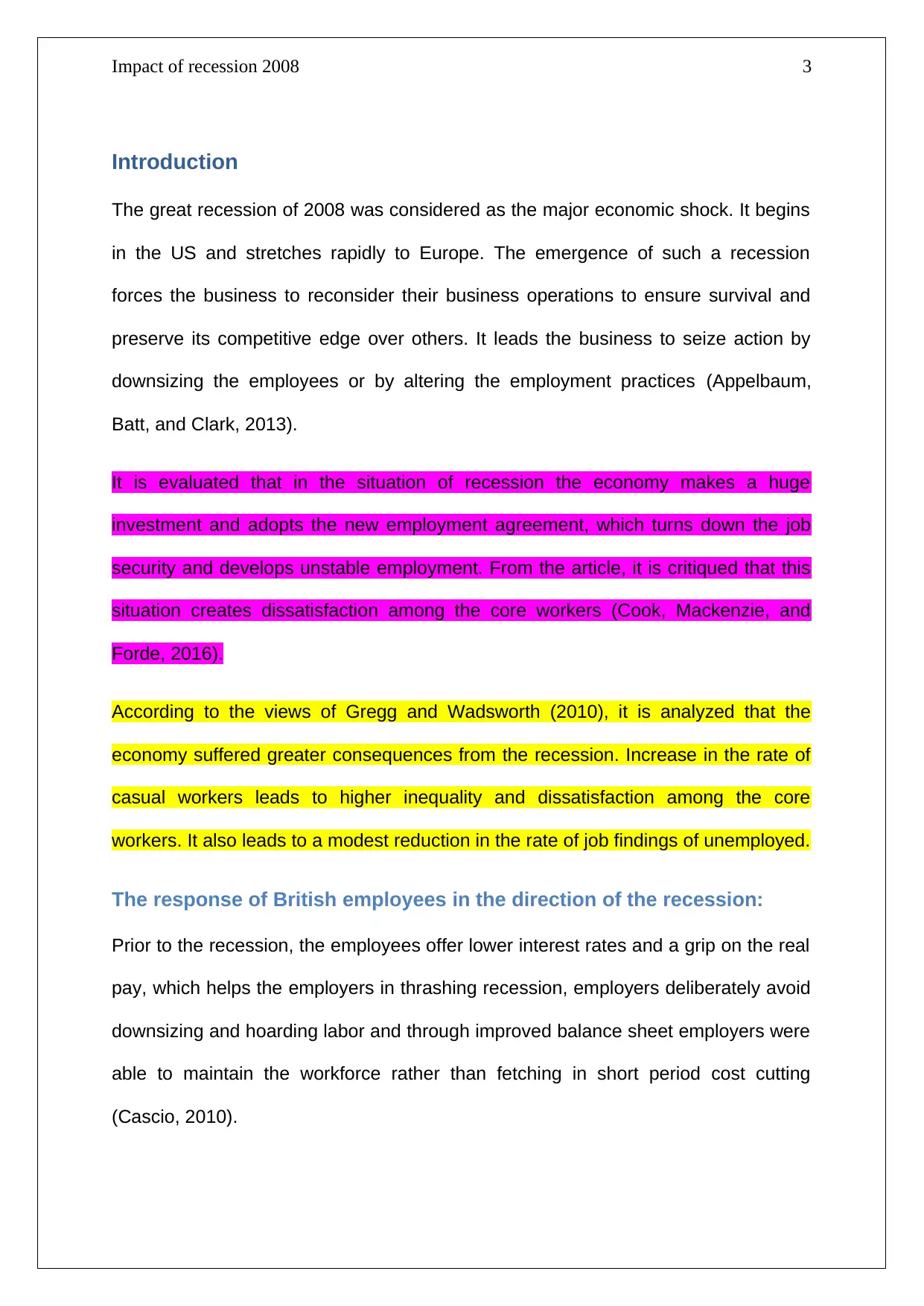
Impact of recession 2008 3
Introduction
The great recession of 2008 was considered as the major economic shock. It begins
in the US and stretches rapidly to Europe. The emergence of such a recession
forces the business to reconsider their business operations to ensure survival and
preserve its competitive edge over others. It leads the business to seize action by
downsizing the employees or by altering the employment practices (Appelbaum,
Batt, and Clark, 2013).
It is evaluated that in the situation of recession the economy makes a huge
investment and adopts the new employment agreement, which turns down the job
security and develops unstable employment. From the article, it is critiqued that this
situation creates dissatisfaction among the core workers (Cook, Mackenzie, and
Forde, 2016).
According to the views of Gregg and Wadsworth (2010), it is analyzed that the
economy suffered greater consequences from the recession. Increase in the rate of
casual workers leads to higher inequality and dissatisfaction among the core
workers. It also leads to a modest reduction in the rate of job findings of unemployed.
The response of British employees in the direction of the recession:
Prior to the recession, the employees offer lower interest rates and a grip on the real
pay, which helps the employers in thrashing recession, employers deliberately avoid
downsizing and hoarding labor and through improved balance sheet employers were
able to maintain the workforce rather than fetching in short period cost cutting
(Cascio, 2010).
Introduction
The great recession of 2008 was considered as the major economic shock. It begins
in the US and stretches rapidly to Europe. The emergence of such a recession
forces the business to reconsider their business operations to ensure survival and
preserve its competitive edge over others. It leads the business to seize action by
downsizing the employees or by altering the employment practices (Appelbaum,
Batt, and Clark, 2013).
It is evaluated that in the situation of recession the economy makes a huge
investment and adopts the new employment agreement, which turns down the job
security and develops unstable employment. From the article, it is critiqued that this
situation creates dissatisfaction among the core workers (Cook, Mackenzie, and
Forde, 2016).
According to the views of Gregg and Wadsworth (2010), it is analyzed that the
economy suffered greater consequences from the recession. Increase in the rate of
casual workers leads to higher inequality and dissatisfaction among the core
workers. It also leads to a modest reduction in the rate of job findings of unemployed.
The response of British employees in the direction of the recession:
Prior to the recession, the employees offer lower interest rates and a grip on the real
pay, which helps the employers in thrashing recession, employers deliberately avoid
downsizing and hoarding labor and through improved balance sheet employers were
able to maintain the workforce rather than fetching in short period cost cutting
(Cascio, 2010).
Paraphrase This Document
Need a fresh take? Get an instant paraphrase of this document with our AI Paraphraser
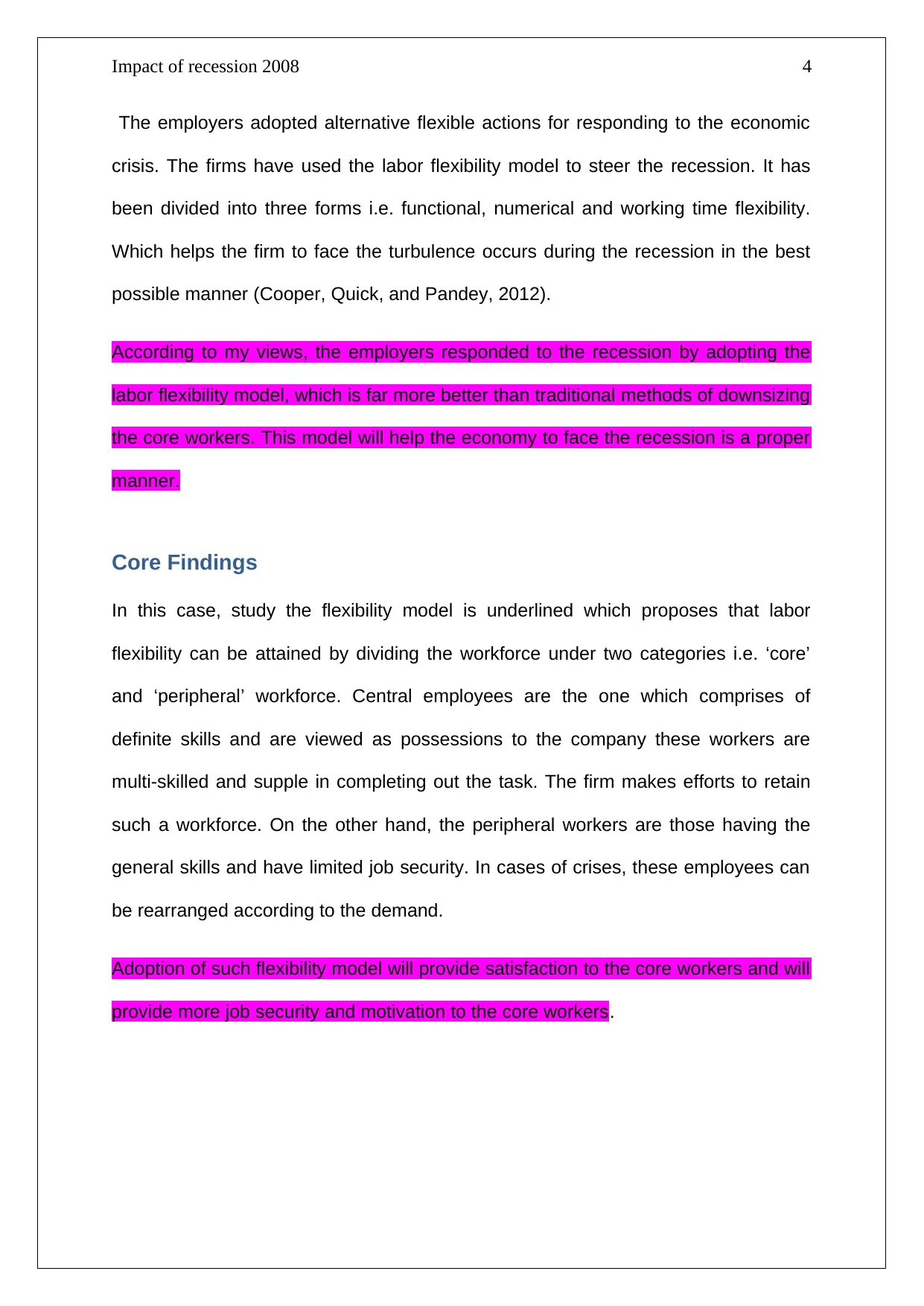
Impact of recession 2008 4
The employers adopted alternative flexible actions for responding to the economic
crisis. The firms have used the labor flexibility model to steer the recession. It has
been divided into three forms i.e. functional, numerical and working time flexibility.
Which helps the firm to face the turbulence occurs during the recession in the best
possible manner (Cooper, Quick, and Pandey, 2012).
According to my views, the employers responded to the recession by adopting the
labor flexibility model, which is far more better than traditional methods of downsizing
the core workers. This model will help the economy to face the recession is a proper
manner.
Core Findings
In this case, study the flexibility model is underlined which proposes that labor
flexibility can be attained by dividing the workforce under two categories i.e. ‘core’
and ‘peripheral’ workforce. Central employees are the one which comprises of
definite skills and are viewed as possessions to the company these workers are
multi-skilled and supple in completing out the task. The firm makes efforts to retain
such a workforce. On the other hand, the peripheral workers are those having the
general skills and have limited job security. In cases of crises, these employees can
be rearranged according to the demand.
Adoption of such flexibility model will provide satisfaction to the core workers and will
provide more job security and motivation to the core workers.
The employers adopted alternative flexible actions for responding to the economic
crisis. The firms have used the labor flexibility model to steer the recession. It has
been divided into three forms i.e. functional, numerical and working time flexibility.
Which helps the firm to face the turbulence occurs during the recession in the best
possible manner (Cooper, Quick, and Pandey, 2012).
According to my views, the employers responded to the recession by adopting the
labor flexibility model, which is far more better than traditional methods of downsizing
the core workers. This model will help the economy to face the recession is a proper
manner.
Core Findings
In this case, study the flexibility model is underlined which proposes that labor
flexibility can be attained by dividing the workforce under two categories i.e. ‘core’
and ‘peripheral’ workforce. Central employees are the one which comprises of
definite skills and are viewed as possessions to the company these workers are
multi-skilled and supple in completing out the task. The firm makes efforts to retain
such a workforce. On the other hand, the peripheral workers are those having the
general skills and have limited job security. In cases of crises, these employees can
be rearranged according to the demand.
Adoption of such flexibility model will provide satisfaction to the core workers and will
provide more job security and motivation to the core workers.
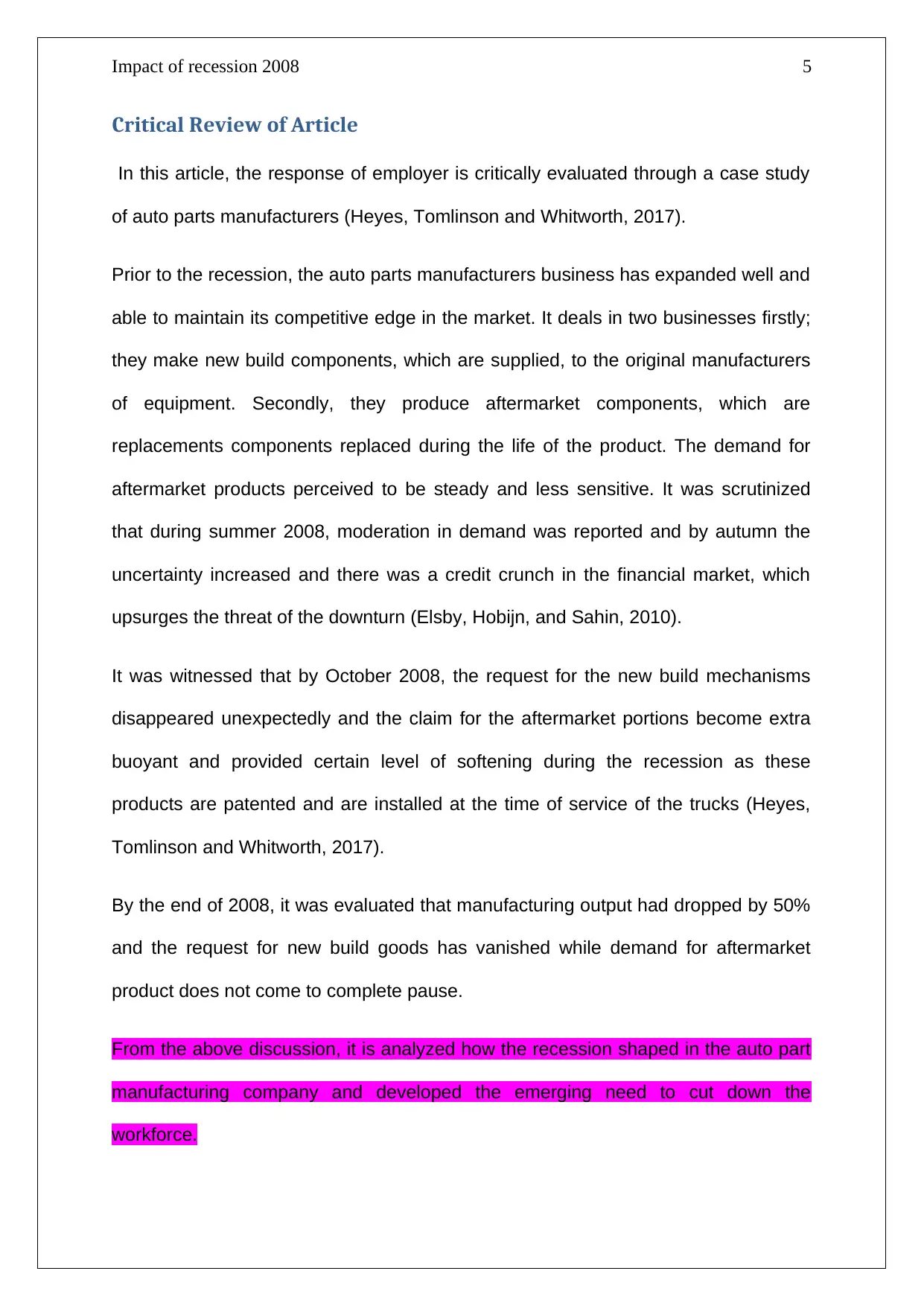
Impact of recession 2008 5
Critical Review of Article
In this article, the response of employer is critically evaluated through a case study
of auto parts manufacturers (Heyes, Tomlinson and Whitworth, 2017).
Prior to the recession, the auto parts manufacturers business has expanded well and
able to maintain its competitive edge in the market. It deals in two businesses firstly;
they make new build components, which are supplied, to the original manufacturers
of equipment. Secondly, they produce aftermarket components, which are
replacements components replaced during the life of the product. The demand for
aftermarket products perceived to be steady and less sensitive. It was scrutinized
that during summer 2008, moderation in demand was reported and by autumn the
uncertainty increased and there was a credit crunch in the financial market, which
upsurges the threat of the downturn (Elsby, Hobijn, and Sahin, 2010).
It was witnessed that by October 2008, the request for the new build mechanisms
disappeared unexpectedly and the claim for the aftermarket portions become extra
buoyant and provided certain level of softening during the recession as these
products are patented and are installed at the time of service of the trucks (Heyes,
Tomlinson and Whitworth, 2017).
By the end of 2008, it was evaluated that manufacturing output had dropped by 50%
and the request for new build goods has vanished while demand for aftermarket
product does not come to complete pause.
From the above discussion, it is analyzed how the recession shaped in the auto part
manufacturing company and developed the emerging need to cut down the
workforce.
Critical Review of Article
In this article, the response of employer is critically evaluated through a case study
of auto parts manufacturers (Heyes, Tomlinson and Whitworth, 2017).
Prior to the recession, the auto parts manufacturers business has expanded well and
able to maintain its competitive edge in the market. It deals in two businesses firstly;
they make new build components, which are supplied, to the original manufacturers
of equipment. Secondly, they produce aftermarket components, which are
replacements components replaced during the life of the product. The demand for
aftermarket products perceived to be steady and less sensitive. It was scrutinized
that during summer 2008, moderation in demand was reported and by autumn the
uncertainty increased and there was a credit crunch in the financial market, which
upsurges the threat of the downturn (Elsby, Hobijn, and Sahin, 2010).
It was witnessed that by October 2008, the request for the new build mechanisms
disappeared unexpectedly and the claim for the aftermarket portions become extra
buoyant and provided certain level of softening during the recession as these
products are patented and are installed at the time of service of the trucks (Heyes,
Tomlinson and Whitworth, 2017).
By the end of 2008, it was evaluated that manufacturing output had dropped by 50%
and the request for new build goods has vanished while demand for aftermarket
product does not come to complete pause.
From the above discussion, it is analyzed how the recession shaped in the auto part
manufacturing company and developed the emerging need to cut down the
workforce.
⊘ This is a preview!⊘
Do you want full access?
Subscribe today to unlock all pages.

Trusted by 1+ million students worldwide
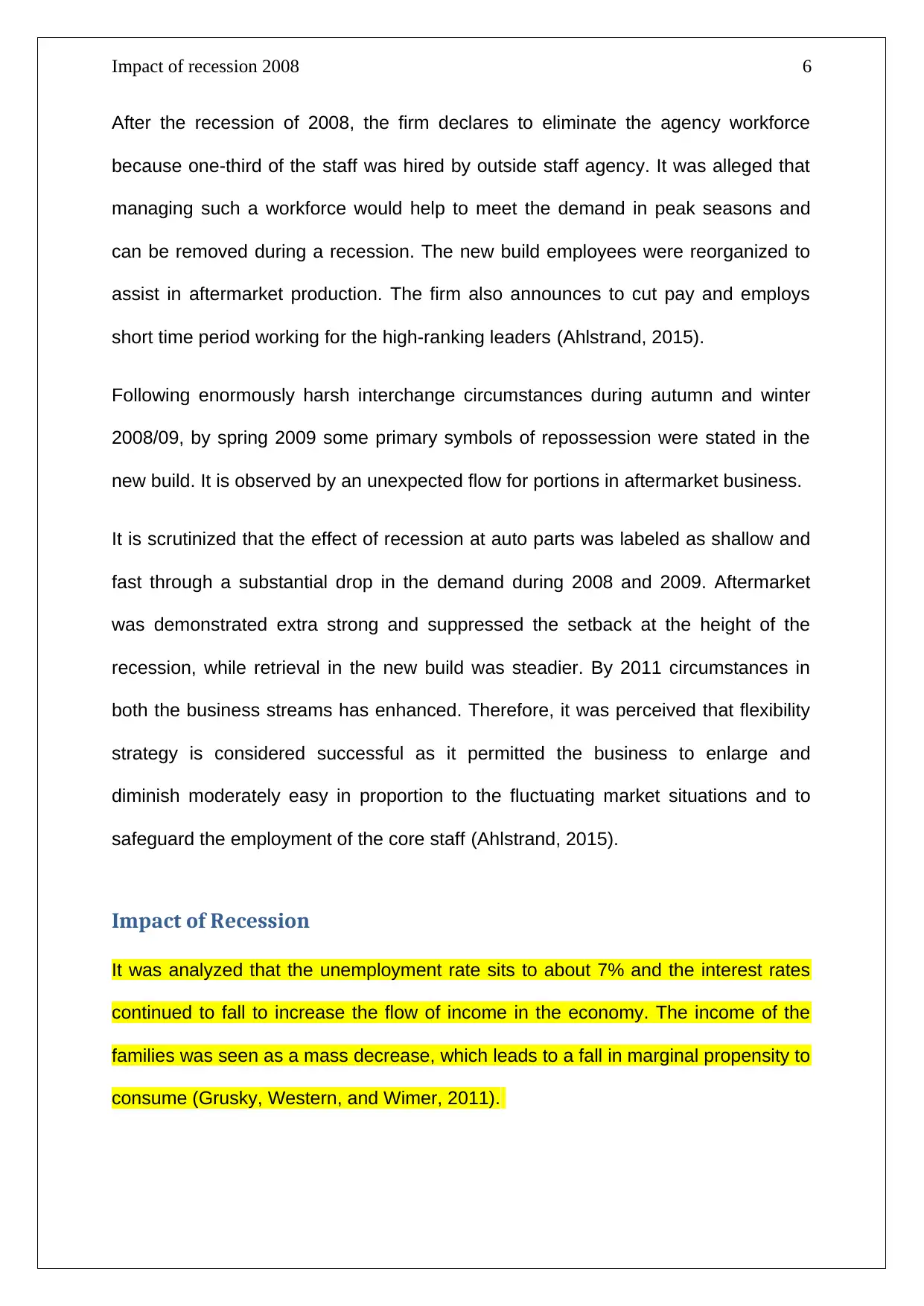
Impact of recession 2008 6
After the recession of 2008, the firm declares to eliminate the agency workforce
because one-third of the staff was hired by outside staff agency. It was alleged that
managing such a workforce would help to meet the demand in peak seasons and
can be removed during a recession. The new build employees were reorganized to
assist in aftermarket production. The firm also announces to cut pay and employs
short time period working for the high-ranking leaders (Ahlstrand, 2015).
Following enormously harsh interchange circumstances during autumn and winter
2008/09, by spring 2009 some primary symbols of repossession were stated in the
new build. It is observed by an unexpected flow for portions in aftermarket business.
It is scrutinized that the effect of recession at auto parts was labeled as shallow and
fast through a substantial drop in the demand during 2008 and 2009. Aftermarket
was demonstrated extra strong and suppressed the setback at the height of the
recession, while retrieval in the new build was steadier. By 2011 circumstances in
both the business streams has enhanced. Therefore, it was perceived that flexibility
strategy is considered successful as it permitted the business to enlarge and
diminish moderately easy in proportion to the fluctuating market situations and to
safeguard the employment of the core staff (Ahlstrand, 2015).
Impact of Recession
It was analyzed that the unemployment rate sits to about 7% and the interest rates
continued to fall to increase the flow of income in the economy. The income of the
families was seen as a mass decrease, which leads to a fall in marginal propensity to
consume (Grusky, Western, and Wimer, 2011).
After the recession of 2008, the firm declares to eliminate the agency workforce
because one-third of the staff was hired by outside staff agency. It was alleged that
managing such a workforce would help to meet the demand in peak seasons and
can be removed during a recession. The new build employees were reorganized to
assist in aftermarket production. The firm also announces to cut pay and employs
short time period working for the high-ranking leaders (Ahlstrand, 2015).
Following enormously harsh interchange circumstances during autumn and winter
2008/09, by spring 2009 some primary symbols of repossession were stated in the
new build. It is observed by an unexpected flow for portions in aftermarket business.
It is scrutinized that the effect of recession at auto parts was labeled as shallow and
fast through a substantial drop in the demand during 2008 and 2009. Aftermarket
was demonstrated extra strong and suppressed the setback at the height of the
recession, while retrieval in the new build was steadier. By 2011 circumstances in
both the business streams has enhanced. Therefore, it was perceived that flexibility
strategy is considered successful as it permitted the business to enlarge and
diminish moderately easy in proportion to the fluctuating market situations and to
safeguard the employment of the core staff (Ahlstrand, 2015).
Impact of Recession
It was analyzed that the unemployment rate sits to about 7% and the interest rates
continued to fall to increase the flow of income in the economy. The income of the
families was seen as a mass decrease, which leads to a fall in marginal propensity to
consume (Grusky, Western, and Wimer, 2011).
Paraphrase This Document
Need a fresh take? Get an instant paraphrase of this document with our AI Paraphraser
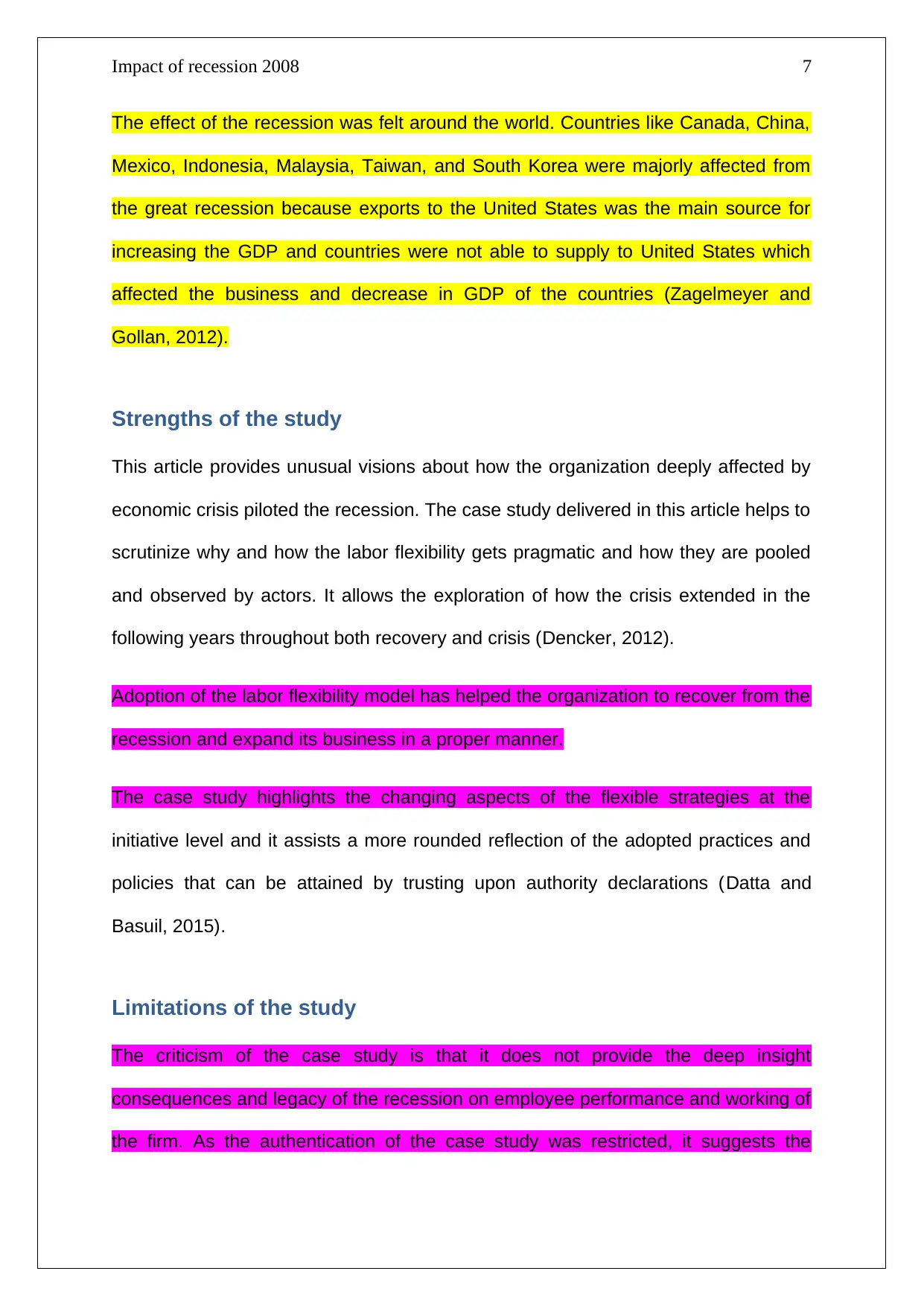
Impact of recession 2008 7
The effect of the recession was felt around the world. Countries like Canada, China,
Mexico, Indonesia, Malaysia, Taiwan, and South Korea were majorly affected from
the great recession because exports to the United States was the main source for
increasing the GDP and countries were not able to supply to United States which
affected the business and decrease in GDP of the countries (Zagelmeyer and
Gollan, 2012).
Strengths of the study
This article provides unusual visions about how the organization deeply affected by
economic crisis piloted the recession. The case study delivered in this article helps to
scrutinize why and how the labor flexibility gets pragmatic and how they are pooled
and observed by actors. It allows the exploration of how the crisis extended in the
following years throughout both recovery and crisis (Dencker, 2012).
Adoption of the labor flexibility model has helped the organization to recover from the
recession and expand its business in a proper manner.
The case study highlights the changing aspects of the flexible strategies at the
initiative level and it assists a more rounded reflection of the adopted practices and
policies that can be attained by trusting upon authority declarations (Datta and
Basuil, 2015).
Limitations of the study
The criticism of the case study is that it does not provide the deep insight
consequences and legacy of the recession on employee performance and working of
the firm. As the authentication of the case study was restricted, it suggests the
The effect of the recession was felt around the world. Countries like Canada, China,
Mexico, Indonesia, Malaysia, Taiwan, and South Korea were majorly affected from
the great recession because exports to the United States was the main source for
increasing the GDP and countries were not able to supply to United States which
affected the business and decrease in GDP of the countries (Zagelmeyer and
Gollan, 2012).
Strengths of the study
This article provides unusual visions about how the organization deeply affected by
economic crisis piloted the recession. The case study delivered in this article helps to
scrutinize why and how the labor flexibility gets pragmatic and how they are pooled
and observed by actors. It allows the exploration of how the crisis extended in the
following years throughout both recovery and crisis (Dencker, 2012).
Adoption of the labor flexibility model has helped the organization to recover from the
recession and expand its business in a proper manner.
The case study highlights the changing aspects of the flexible strategies at the
initiative level and it assists a more rounded reflection of the adopted practices and
policies that can be attained by trusting upon authority declarations (Datta and
Basuil, 2015).
Limitations of the study
The criticism of the case study is that it does not provide the deep insight
consequences and legacy of the recession on employee performance and working of
the firm. As the authentication of the case study was restricted, it suggests the
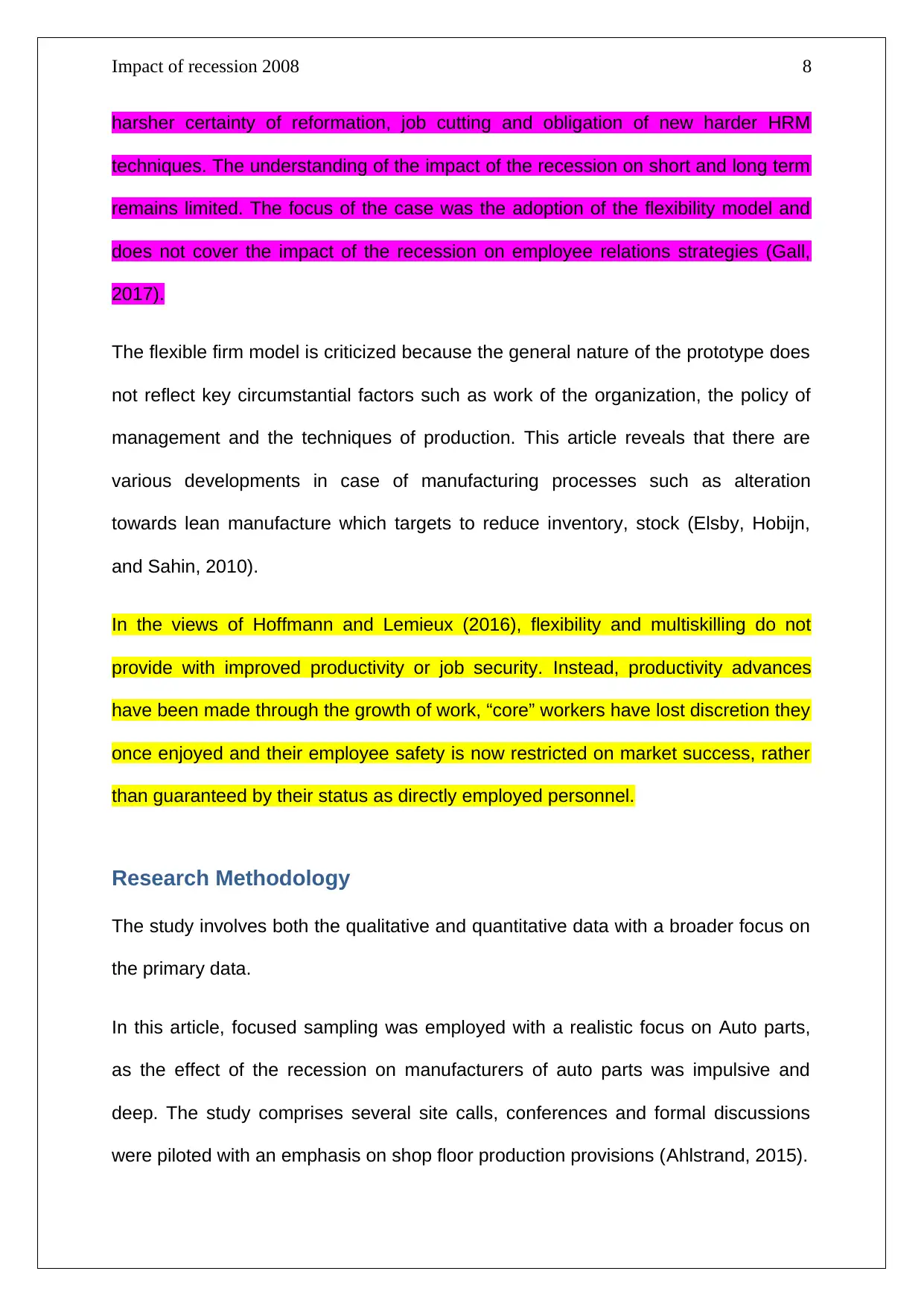
Impact of recession 2008 8
harsher certainty of reformation, job cutting and obligation of new harder HRM
techniques. The understanding of the impact of the recession on short and long term
remains limited. The focus of the case was the adoption of the flexibility model and
does not cover the impact of the recession on employee relations strategies (Gall,
2017).
The flexible firm model is criticized because the general nature of the prototype does
not reflect key circumstantial factors such as work of the organization, the policy of
management and the techniques of production. This article reveals that there are
various developments in case of manufacturing processes such as alteration
towards lean manufacture which targets to reduce inventory, stock (Elsby, Hobijn,
and Sahin, 2010).
In the views of Hoffmann and Lemieux (2016), flexibility and multiskilling do not
provide with improved productivity or job security. Instead, productivity advances
have been made through the growth of work, “core” workers have lost discretion they
once enjoyed and their employee safety is now restricted on market success, rather
than guaranteed by their status as directly employed personnel.
Research Methodology
The study involves both the qualitative and quantitative data with a broader focus on
the primary data.
In this article, focused sampling was employed with a realistic focus on Auto parts,
as the effect of the recession on manufacturers of auto parts was impulsive and
deep. The study comprises several site calls, conferences and formal discussions
were piloted with an emphasis on shop floor production provisions (Ahlstrand, 2015).
harsher certainty of reformation, job cutting and obligation of new harder HRM
techniques. The understanding of the impact of the recession on short and long term
remains limited. The focus of the case was the adoption of the flexibility model and
does not cover the impact of the recession on employee relations strategies (Gall,
2017).
The flexible firm model is criticized because the general nature of the prototype does
not reflect key circumstantial factors such as work of the organization, the policy of
management and the techniques of production. This article reveals that there are
various developments in case of manufacturing processes such as alteration
towards lean manufacture which targets to reduce inventory, stock (Elsby, Hobijn,
and Sahin, 2010).
In the views of Hoffmann and Lemieux (2016), flexibility and multiskilling do not
provide with improved productivity or job security. Instead, productivity advances
have been made through the growth of work, “core” workers have lost discretion they
once enjoyed and their employee safety is now restricted on market success, rather
than guaranteed by their status as directly employed personnel.
Research Methodology
The study involves both the qualitative and quantitative data with a broader focus on
the primary data.
In this article, focused sampling was employed with a realistic focus on Auto parts,
as the effect of the recession on manufacturers of auto parts was impulsive and
deep. The study comprises several site calls, conferences and formal discussions
were piloted with an emphasis on shop floor production provisions (Ahlstrand, 2015).
⊘ This is a preview!⊘
Do you want full access?
Subscribe today to unlock all pages.

Trusted by 1+ million students worldwide
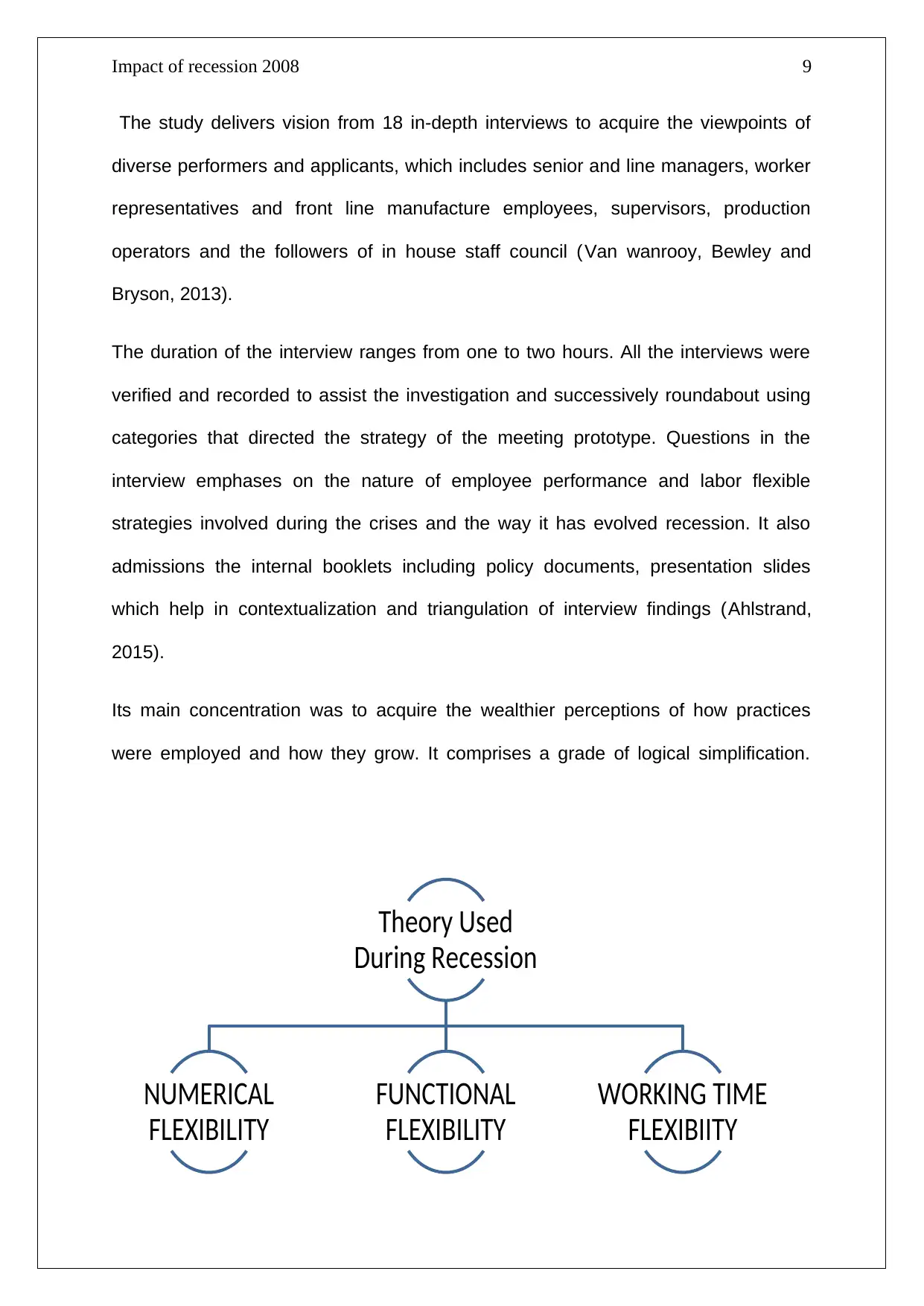
Impact of recession 2008 9
The study delivers vision from 18 in-depth interviews to acquire the viewpoints of
diverse performers and applicants, which includes senior and line managers, worker
representatives and front line manufacture employees, supervisors, production
operators and the followers of in house staff council (Van wanrooy, Bewley and
Bryson, 2013).
The duration of the interview ranges from one to two hours. All the interviews were
verified and recorded to assist the investigation and successively roundabout using
categories that directed the strategy of the meeting prototype. Questions in the
interview emphases on the nature of employee performance and labor flexible
strategies involved during the crises and the way it has evolved recession. It also
admissions the internal booklets including policy documents, presentation slides
which help in contextualization and triangulation of interview findings (Ahlstrand,
2015).
Its main concentration was to acquire the wealthier perceptions of how practices
were employed and how they grow. It comprises a grade of logical simplification.
Theory Used
During Recession
NUMERICAL
FLEXIBILITY
FUNCTIONAL
FLEXIBILITY
WORKING TIME
FLEXIBIITY
The study delivers vision from 18 in-depth interviews to acquire the viewpoints of
diverse performers and applicants, which includes senior and line managers, worker
representatives and front line manufacture employees, supervisors, production
operators and the followers of in house staff council (Van wanrooy, Bewley and
Bryson, 2013).
The duration of the interview ranges from one to two hours. All the interviews were
verified and recorded to assist the investigation and successively roundabout using
categories that directed the strategy of the meeting prototype. Questions in the
interview emphases on the nature of employee performance and labor flexible
strategies involved during the crises and the way it has evolved recession. It also
admissions the internal booklets including policy documents, presentation slides
which help in contextualization and triangulation of interview findings (Ahlstrand,
2015).
Its main concentration was to acquire the wealthier perceptions of how practices
were employed and how they grow. It comprises a grade of logical simplification.
Theory Used
During Recession
NUMERICAL
FLEXIBILITY
FUNCTIONAL
FLEXIBILITY
WORKING TIME
FLEXIBIITY
Paraphrase This Document
Need a fresh take? Get an instant paraphrase of this document with our AI Paraphraser
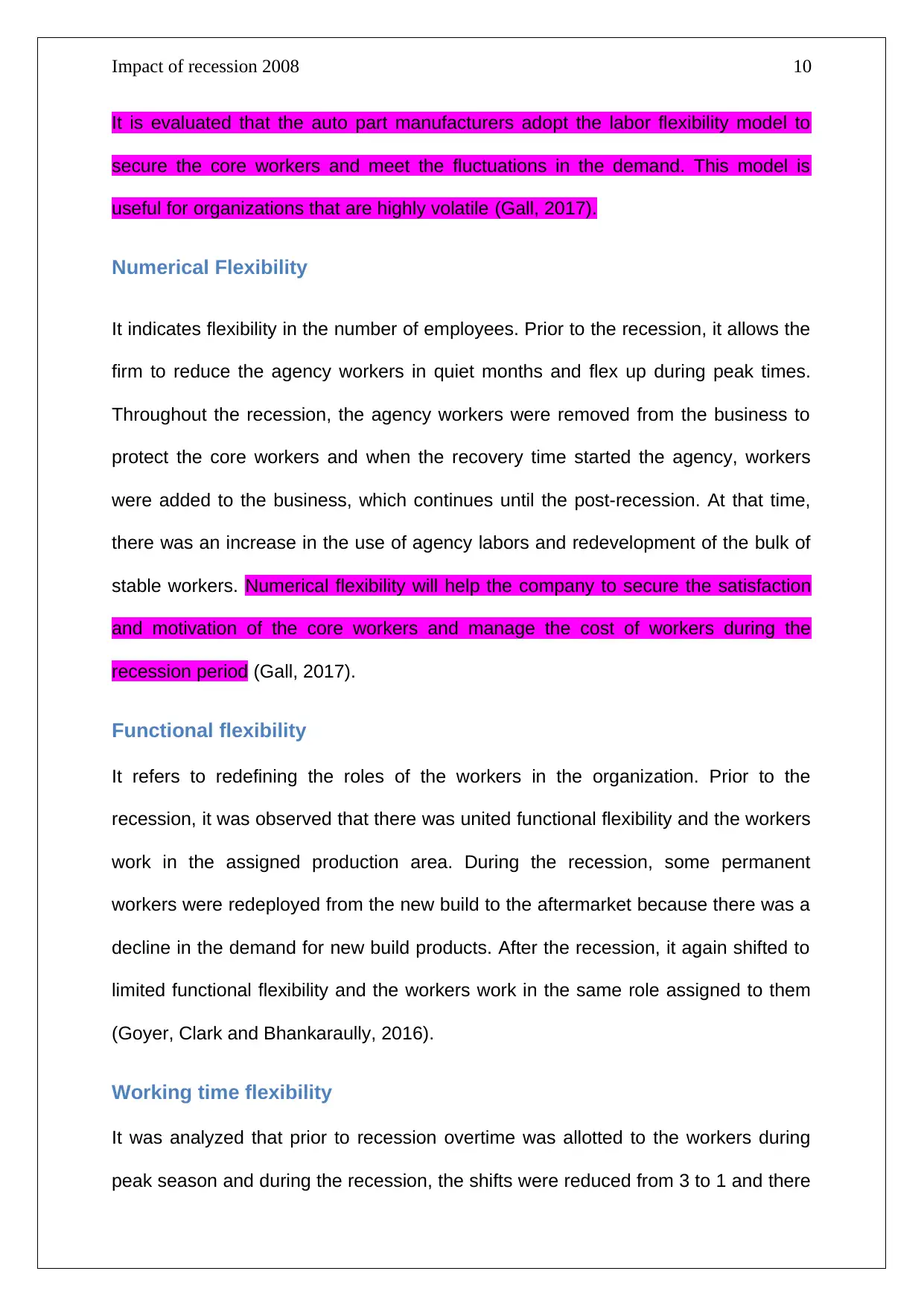
Impact of recession 2008 10
It is evaluated that the auto part manufacturers adopt the labor flexibility model to
secure the core workers and meet the fluctuations in the demand. This model is
useful for organizations that are highly volatile (Gall, 2017).
Numerical Flexibility
It indicates flexibility in the number of employees. Prior to the recession, it allows the
firm to reduce the agency workers in quiet months and flex up during peak times.
Throughout the recession, the agency workers were removed from the business to
protect the core workers and when the recovery time started the agency, workers
were added to the business, which continues until the post-recession. At that time,
there was an increase in the use of agency labors and redevelopment of the bulk of
stable workers. Numerical flexibility will help the company to secure the satisfaction
and motivation of the core workers and manage the cost of workers during the
recession period (Gall, 2017).
Functional flexibility
It refers to redefining the roles of the workers in the organization. Prior to the
recession, it was observed that there was united functional flexibility and the workers
work in the assigned production area. During the recession, some permanent
workers were redeployed from the new build to the aftermarket because there was a
decline in the demand for new build products. After the recession, it again shifted to
limited functional flexibility and the workers work in the same role assigned to them
(Goyer, Clark and Bhankaraully, 2016).
Working time flexibility
It was analyzed that prior to recession overtime was allotted to the workers during
peak season and during the recession, the shifts were reduced from 3 to 1 and there
It is evaluated that the auto part manufacturers adopt the labor flexibility model to
secure the core workers and meet the fluctuations in the demand. This model is
useful for organizations that are highly volatile (Gall, 2017).
Numerical Flexibility
It indicates flexibility in the number of employees. Prior to the recession, it allows the
firm to reduce the agency workers in quiet months and flex up during peak times.
Throughout the recession, the agency workers were removed from the business to
protect the core workers and when the recovery time started the agency, workers
were added to the business, which continues until the post-recession. At that time,
there was an increase in the use of agency labors and redevelopment of the bulk of
stable workers. Numerical flexibility will help the company to secure the satisfaction
and motivation of the core workers and manage the cost of workers during the
recession period (Gall, 2017).
Functional flexibility
It refers to redefining the roles of the workers in the organization. Prior to the
recession, it was observed that there was united functional flexibility and the workers
work in the assigned production area. During the recession, some permanent
workers were redeployed from the new build to the aftermarket because there was a
decline in the demand for new build products. After the recession, it again shifted to
limited functional flexibility and the workers work in the same role assigned to them
(Goyer, Clark and Bhankaraully, 2016).
Working time flexibility
It was analyzed that prior to recession overtime was allotted to the workers during
peak season and during the recession, the shifts were reduced from 3 to 1 and there
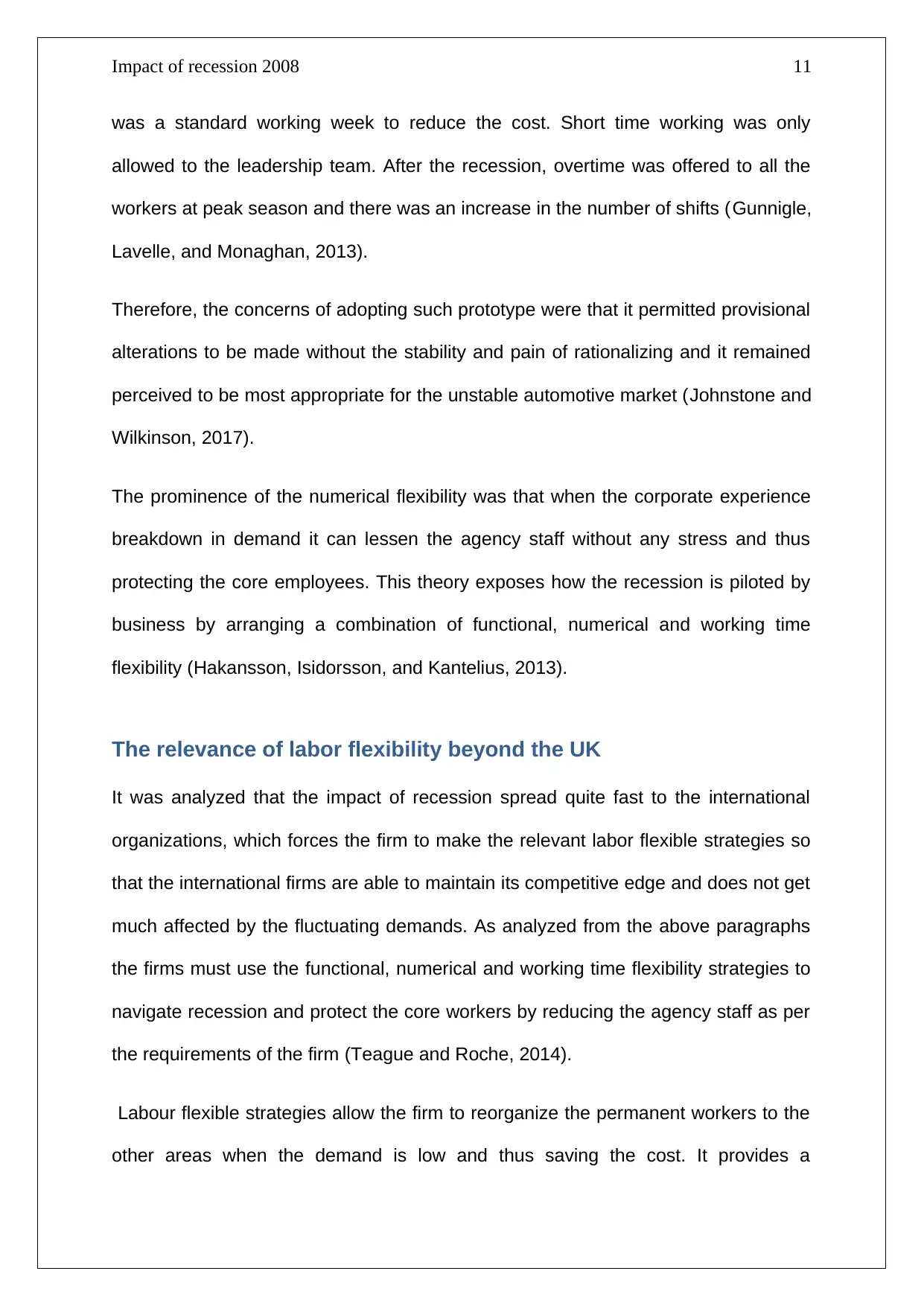
Impact of recession 2008 11
was a standard working week to reduce the cost. Short time working was only
allowed to the leadership team. After the recession, overtime was offered to all the
workers at peak season and there was an increase in the number of shifts (Gunnigle,
Lavelle, and Monaghan, 2013).
Therefore, the concerns of adopting such prototype were that it permitted provisional
alterations to be made without the stability and pain of rationalizing and it remained
perceived to be most appropriate for the unstable automotive market (Johnstone and
Wilkinson, 2017).
The prominence of the numerical flexibility was that when the corporate experience
breakdown in demand it can lessen the agency staff without any stress and thus
protecting the core employees. This theory exposes how the recession is piloted by
business by arranging a combination of functional, numerical and working time
flexibility (Hakansson, Isidorsson, and Kantelius, 2013).
The relevance of labor flexibility beyond the UK
It was analyzed that the impact of recession spread quite fast to the international
organizations, which forces the firm to make the relevant labor flexible strategies so
that the international firms are able to maintain its competitive edge and does not get
much affected by the fluctuating demands. As analyzed from the above paragraphs
the firms must use the functional, numerical and working time flexibility strategies to
navigate recession and protect the core workers by reducing the agency staff as per
the requirements of the firm (Teague and Roche, 2014).
Labour flexible strategies allow the firm to reorganize the permanent workers to the
other areas when the demand is low and thus saving the cost. It provides a
was a standard working week to reduce the cost. Short time working was only
allowed to the leadership team. After the recession, overtime was offered to all the
workers at peak season and there was an increase in the number of shifts (Gunnigle,
Lavelle, and Monaghan, 2013).
Therefore, the concerns of adopting such prototype were that it permitted provisional
alterations to be made without the stability and pain of rationalizing and it remained
perceived to be most appropriate for the unstable automotive market (Johnstone and
Wilkinson, 2017).
The prominence of the numerical flexibility was that when the corporate experience
breakdown in demand it can lessen the agency staff without any stress and thus
protecting the core employees. This theory exposes how the recession is piloted by
business by arranging a combination of functional, numerical and working time
flexibility (Hakansson, Isidorsson, and Kantelius, 2013).
The relevance of labor flexibility beyond the UK
It was analyzed that the impact of recession spread quite fast to the international
organizations, which forces the firm to make the relevant labor flexible strategies so
that the international firms are able to maintain its competitive edge and does not get
much affected by the fluctuating demands. As analyzed from the above paragraphs
the firms must use the functional, numerical and working time flexibility strategies to
navigate recession and protect the core workers by reducing the agency staff as per
the requirements of the firm (Teague and Roche, 2014).
Labour flexible strategies allow the firm to reorganize the permanent workers to the
other areas when the demand is low and thus saving the cost. It provides a
⊘ This is a preview!⊘
Do you want full access?
Subscribe today to unlock all pages.

Trusted by 1+ million students worldwide
1 out of 17
Related Documents
Your All-in-One AI-Powered Toolkit for Academic Success.
+13062052269
info@desklib.com
Available 24*7 on WhatsApp / Email
![[object Object]](/_next/static/media/star-bottom.7253800d.svg)
Unlock your academic potential
Copyright © 2020–2025 A2Z Services. All Rights Reserved. Developed and managed by ZUCOL.





